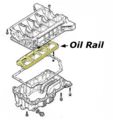@Hugo Albuquerque creio que em tempos fiquei de te enviar este texto. Já não me lembro se foi aqui ou através do fórum do Clube...
Com toda a certeza nada disto deve ser novidade para ti!
Cá vai:
K-Series problems
The engine's head-gasket was made from a steel core plate with silicon rubber beads to seal water and oil ways rather than the more traditional materials. However, the redesign of the cylinder block to enable the capacity to stretch to 1600 and 1800 cc resulted in a lack of stiffness. This allowed movement across the gasket face and subsequent gasket failure. The design of the cooling circuit was also less than optimum, allowing a hot engine to be suddenly flushed with cold water when the thermostat opened. This "thermal shock" put more stress across the gasket face. These factors were particularly severe in larger vehicles such as the Land Rover Freelander.
Due to the wish to make the engine as efficient as possible, the coolant capacity was smaller than would be expected in engines of this size. This enabled the engine to reach its optimum operating temperature quickly. However, the smaller coolant capacity did make the engine vulnerable in the event of coolant leaks. This became more of a problem with the larger capacity engines, as the extra swept volume was achieved by eating into the water jacket, further reducing coolant capacity.
The Freelander problem was relieved to a certain extent by a special pressure release thermostat which, with the aid of a spring loaded valve, allowed a small amount of coolant to bypass the thermostat at high engine speeds regardless of engine temperature.
A modification made in an attempt to reduce the rate of gasket failure was to replace the plastic dowels with steel dowels in the cylinder block top face. This helps reduce the head movement relative to the cylinder block. The rubber sealing beads were also modified to give improved attachment to the gasket core plate.
More recently, Land Rover have released a reinforced MLS (Multi-Layer Steel) head gasket for the K-Series engines, which until mid-2005 were fitted to the 1800 cc petrol variants of their Freelander model. A modified oil rail was also developed to be used in conjunction with the gasket to improve block stiffness. Time will tell as to whether the improved design will cure this fault of the K-Series engine, but many professionals and enthusiasts now recommend this new design over the standard gasket as fitted by MG-Rover. To date, the results appear to be good.
In the motor trade, most unmodified K-Series engines are expected to suffer head-gasket failure at around 90,000 miles. Water and oil mixing, resulting in the dip-stick being coated in a brown slush is the most common symptom, requiring significant effort to clean out before replacement.
 12719439_587140358121836_503086523255081291_o_zpsba10qxhe.jpg82.6 KB · Vistos: 0
12719439_587140358121836_503086523255081291_o_zpsba10qxhe.jpg82.6 KB · Vistos: 0 12898154_587140431455162_5245783492165573734_o_zpskdnihq03.jpg75.6 KB · Vistos: 0
12898154_587140431455162_5245783492165573734_o_zpskdnihq03.jpg75.6 KB · Vistos: 0 12719439_587140358121836_503086523255081291_o_zpsba10qxhe.jpg82.6 KB · Vistos: 0
12719439_587140358121836_503086523255081291_o_zpsba10qxhe.jpg82.6 KB · Vistos: 0 12719439_587140358121836_503086523255081291_o_zpsba10qxhe.jpg82.6 KB · Vistos: 0
12719439_587140358121836_503086523255081291_o_zpsba10qxhe.jpg82.6 KB · Vistos: 0 12719439_587140358121836_503086523255081291_o_zpsba10qxhe.jpg82.6 KB · Vistos: 0
12719439_587140358121836_503086523255081291_o_zpsba10qxhe.jpg82.6 KB · Vistos: 0 12719439_587140358121836_503086523255081291_o_zpsba10qxhe.jpg82.6 KB · Vistos: 0
12719439_587140358121836_503086523255081291_o_zpsba10qxhe.jpg82.6 KB · Vistos: 0 12719439_587140358121836_503086523255081291_o_zpsba10qxhe.jpg82.6 KB · Vistos: 0
12719439_587140358121836_503086523255081291_o_zpsba10qxhe.jpg82.6 KB · Vistos: 0 12898154_587140431455162_5245783492165573734_o_zpskdnihq03.jpg75.6 KB · Vistos: 0
12898154_587140431455162_5245783492165573734_o_zpskdnihq03.jpg75.6 KB · Vistos: 0 12898154_587140431455162_5245783492165573734_o_zpskdnihq03.jpg75.6 KB · Vistos: 0
12898154_587140431455162_5245783492165573734_o_zpskdnihq03.jpg75.6 KB · Vistos: 0 12898154_587140431455162_5245783492165573734_o_zpskdnihq03.jpg75.6 KB · Vistos: 0
12898154_587140431455162_5245783492165573734_o_zpskdnihq03.jpg75.6 KB · Vistos: 0 12898154_587140431455162_5245783492165573734_o_zpskdnihq03.jpg75.6 KB · Vistos: 0
12898154_587140431455162_5245783492165573734_o_zpskdnihq03.jpg75.6 KB · Vistos: 0 12898154_587140431455162_5245783492165573734_o_zpskdnihq03.jpg75.6 KB · Vistos: 0
12898154_587140431455162_5245783492165573734_o_zpskdnihq03.jpg75.6 KB · Vistos: 0 12719439_587140358121836_503086523255081291_o_zpsba10qxhe.jpg82.6 KB · Vistos: 4
12719439_587140358121836_503086523255081291_o_zpsba10qxhe.jpg82.6 KB · Vistos: 4 12898154_587140431455162_5245783492165573734_o_zpskdnihq03.jpg75.6 KB · Vistos: 4
12898154_587140431455162_5245783492165573734_o_zpskdnihq03.jpg75.6 KB · Vistos: 4


























